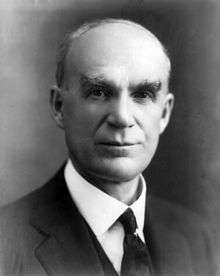Simeon D. Fess
| Simeon Fess | |
|---|---|
 | |
| Chair of the Republican National Committee | |
|
In office 1930–1932 | |
| Preceded by | Claudius H. Huston |
| Succeeded by | Everett Sanders |
| Senate Majority Whip | |
|
In office March 4, 1929 – January 3, 1933 | |
| Leader | James Eli Watson |
| Preceded by | Wesley Jones |
| Succeeded by | J. Hamilton Lewis |
| United States Senator from Ohio | |
|
In office March 4, 1923 – January 3, 1935 | |
| Preceded by | Atlee Pomerene |
| Succeeded by | A. Victor Donahey |
| Member of the U.S. House of Representatives from Ohio's 7th district | |
|
In office March 4, 1915 – March 4, 1923 | |
| Preceded by | James D. Post |
| Succeeded by | Charles Brand |
| Member of the U.S. House of Representatives from Ohio's 6th district | |
|
In office March 4, 1913 – March 4, 1915 | |
| Preceded by | Matthew Denver |
| Succeeded by | Charles Cyrus Kearns |
| Personal details | |
| Born |
Simeon Davison Fess December 11, 1861 Harrod, Ohio, U.S. |
| Died |
December 23, 1936 (aged 75) Washington, D.C., U.S. |
| Political party | Republican |
| Education | Ohio Northern University (BA, LLB) |
Simeon Davison Fess (December 11, 1861 – December 23, 1936) was a Republican politician and educator from Ohio. He served in the United States House of Representatives and U.S. Senate.
Early life
Born on a farm near Harrod, Ohio to Henry and Barbara (Herring) Fess, he was educated in country schools and graduated at Ohio Northern University of Ada in 1889 and married Eva C. Thomas the following year. After graduation, he taught history and law at the university as well was working in the university administration from 1889-1896. Fess graduated from the law department at ONU in 1894 and served as dean of that department from 1896-1900. He then served as vice president of the university 1900-1902. He left for Illinois to become a graduate student and lecturer at the University of Chicago from 1902-1907. He then returned to Ohio and served as the president of Antioch College of Yellow Springs from 1907 to 1917.
Politics
In 1912, while still serving at Antioch College, Fess was a delegate to the state constitutional convention as well as being elected as a Republican to the U.S. House of Representatives, serving from March 4, 1913 – March 3, 1923 (6th District 1913-15, 7th District 1915-23). He served as chairman of the Committee on Education during the Sixty-sixth and Sixty-seventh Congresses and chairman of the Republican National Congressional Committee from 1918-1922. In 1922 he did not seek re-election, but ran for the U.S. Senate and won serving from March 4, 1923, to January 3, 1935. He served as chairman of the Committee on the Library during Sixty-ninth through Seventy-second Congresses and as Republican Whip from 1929 to 1933. He also served as chairman of the Republican National Committee 1930-32. Running the GOP during the depths of the Depression was a thankless task. After his appointment, the Cincinnati Enquirer referred to Fess as a "party wheelhouse and stand patter of the most approved type," and added "It was Senator Fess's proven ability not only to defend, but to eulogize, the acts of Republican administrations, no matter how unpopular they may be, that led to his selection as national chairman."[1] Fess campaigned for the reelection of President Herbert Hoover by claiming Hoover was "the country's greatest peacetime leader,"[2] a hard sell in the fall of 1932. That speech, a month before the presidential election, was delivered to just 150 listeners,[3] a sign of the Republican Party's problems in mid-Depression. He was an unsuccessful candidate for a third term as Senator in 1934.
Retirement and death
Fess was a Methodist, an editor, an author and a member of the Freemasons and Knights of Pythias. He died in Washington, D.C. at the age of 75 and is interred at Glen Forest Cemetery in Yellow Springs, Ohio.[4]
References
- ↑ Cincinnati Enquirer, August 11, 1930, p. 4
- ↑ Marion [Ohio] Star, October 5, 1932, p. 1.
- ↑ Ibid.
- ↑ "Simeon D. Fess". Find A Grave. Retrieved 24 August 2012.
External links
| Wikimedia Commons has media related to Simeon D. Fess. |

